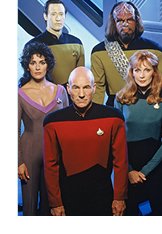Pioneering Explorers: How Open Systems Embrace Diversity In Science Fiction And In Real Life
Greetings *|FNAME|*,

Dubbed "The Princeton of the South", Davidson was established in 1837 as a men's college by the Presbyterians of North Carolina. 136 years later, the first women's class was admitted into Davidson. I was a member of that class when I started my freshman post-secondary academic year. Over time, we became labeled the "Pioneers" because we were exploring the unknown together.
This pioneering change didn't come without cost. A number of legacy Davidson donors withdrew their support in protest, and fomented dissent. When we started classes, there had been no renovations, so the women's restrooms still had stand-up urinals. You can imagine the amount of soul-searching all around campus and outside of it. But eventually, forward-thinking leadership prevailed. Davidson has an even stronger legacy now.

Fast forward to 2023. Earlier this month, I attended the Davidson celebration of 50 years of coeducation. I loved celebrating this coeducation milestone with my fellow Pioneers. Our large, diverse community, so full of success, achievement, and lives well-lived, is a sterling example of the possibilities when a previously closed system decides to open up to new voices and ideas. But beyond greater opportunity, what else do you think typifies a closed system versus an open system? I'm a big fan of science fiction, so here's an easy way to look at it:
Foundation. Apple TV's Foundation is an excellent sci-fi series based on the Foundation Trilogy by Isaac Asimov. The plot explores how each member of the ruling genetic and generational triumvirate faces new challenges, withe the expectation that the sameness of their genetic basis guarantees effective societal control in an autocratic, closed system. There are no options for a different ruling approach, thinking approach, or behavioral approach. The cloned characters believe that over time, this closed system, this sameness, will replicate the same historical results forward: dynastic rule in perpetuity.

Operating in a closed system with no variation in leadership approach and no embrace of diverse thinking might feel safe for some. But it's not actually safety; it's just familiarity. This illusion in a closed system promotes decay, because inevitable external forces WILL impinge upon us, and closed systems aren't capable of adapting when powerful counter forces arise. Based in the model of strong self-regulation engagement activity, adaptability also works similar to a muscle. If you don't exercise it, then it will atrophy. This is true for companies and organizations of all sizes, who can't generate new ideas to pivot during a long-term shift or short-term crisis due to internal and/or external events.
Star Trek. The many series of this franchise also depict tension between closed and open systems, but those in the Star Trek universe champion the latter. We see cooperation between very different cultures (Klingons and Vulcans), and the Federation's ethical struggle with exploring the unknown while refraining from interference with, or dominion of, the less "evolved" or technologically-advanced. We see how scarcity, miscommunication, and misunderstandings perpetuate conflict and war between Cardassians, Bajorans, Romulans, Ferengi, and countless intelligent species. We even see how a technologically-advanced, closed system that is diametrically opposed to the ideals of cultural respect in favor of assimilation (the Borg), perish because of its lack of meaningful variation.

Conflict reflects a deep concern of the human condition and is easy to identify within even fictional stories. We write what we know, right? To combat conflict, we must adhere to a set of values that favor respect over expedience. In this way, we can help mitigate destruction on the micro, macro, or galactic scale. But even when self-respect and other-respect are central in our workplace(s), how do we engage someone who finds it difficult to show respect for others?
It's not easy. But we must be willing to be challenged to rethink our stances and broaden our approach to work, and to life. We must consider different perspectives, different circumstances, different decisions, and different actions. Open systems require external interaction to internally generate new, more effective solutions to new problems. Open systems promote a back-and-forth discussion between the internal and external, helping to overcome sameness traps. Open systems break social echo chambers and diversify monoculture. And through the interaction with those who are different, winning solutions to challenges combine the best parts of multiple perspectives. German philosopher Georg Hegel calls this "Thesis, Antithesis, and Synthesis."
Now not all things 'new' are good, or all things 'old' are bad. We must grapple with life using our best thinking, an open heart, our beliefs and inclusive values to embrace the perceived 'other.' It is usually challenging because of the inherent discomfort that comes from carefully considering other viewpoints in as unbiased a manner as possible. And it does not mean that we open wide our boundaries to any and all perspectives. We consider... but don't necessarily adopt everything. Nonetheless, that's the road to cultivating an open system.

Embracing internal diversity within your organization helps speed up the process. My Grandson Archer (shown here as Captain Kirk for Halloween this year) is a big fan of Star Trek like I am. He doesn't know the historical significance of Kirk and Ohura's kiss. Or Benjamin Sisko in DS9. Or Captain Janeway in Voyager. Archer just likes outer space and adventure. But he's indirectly seeing how the diversity of thought and behavior can be challenging to those of us who don't like to be called upon to see things differently and to behave differently. In a small way, too, he is absorbing the idea that by grappling with new perspectives, new people/aliens, and even those we might already find irritating or uncomfortable to be around, we adapt and grow.
Instructional design and performance improvement digs deep to determine the root cause of deviation from goals. These processes consider the broader system that impacts an organization... especially external things they might not readily recognize. Considering internal and external systemic elements together when determining the root cause(s) of issues helps produce the best solution and realigns a business or non-profit to a successful trajectory instead of eventually failing.
A key part of our own secret sauce is the diversity of perspectives and mindsets among our team. I have doggedly worked to create a culture in Change by Design where talent, focus, training, experience, precision, outcome, and work ethic are strongly valued. It is joyful to provide work opportunities in which colleagues can do their best work, while also showing respect and practicing compromise.
As a leader in your organization, keep asking people who are different for input, because perspectives can change over time. If you have a person or group of people who raise red flags, open-mindedly consider what part of what they say might be correct, and acknowledge it. Give them the benefit of the doubt, but of course do it cautiously. Respectfully demonstrate how you have carefully considered their viewpoint, thank them for their input, and if you can't incorporate all the changes because of financial reasons, or some other strategic obligation, again show respect by explaining why. This approach may also help you avoid losing team members, or even creating a new competitor.
Live long and prosper,


Sue
Email | LinkedIn | V-Card